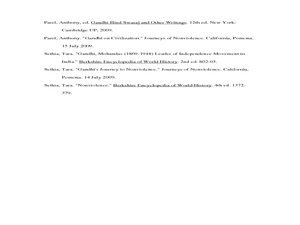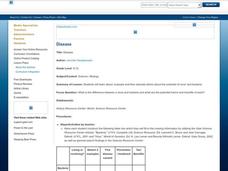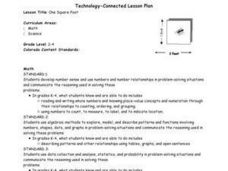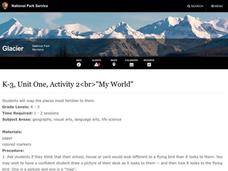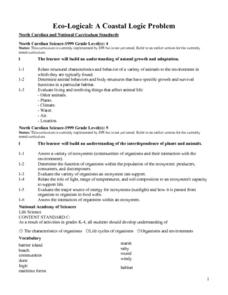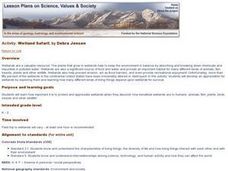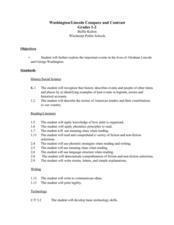Curated OER
Creating Animal Prints
Students investigate the habits of animals by studying their prints. In this animal life lesson, students investigate the different types of tracks left from animals by researching the Internet. Students utilize clay or...
Curated OER
What is electrical energy?
Students distinguish between items with and without energy. In this energy lesson, students understand that natural resources power electrical apparatus and that energy needs to be saved.
Curated OER
Nonviolence and Conflict: Its Importance to Building Community
Young scholars study nonviolence and the values associated with nonviolence. In this social science lesson, students identify the six steps of nonviolence and the six principles of nonviolence as put forth by Martin Luther King, Jr....
Curated OER
Disease
High schoolers study the differences between viruses and bacteria. They educate others to the harms and benefits of each by making a newspaper ad, pamphlet or informative article.
Curated OER
Factors Affecting Plant Growth
Students determine the physical and chemical factors that affect plant growth. In this biology activity, students explain the role of hormones in plants. They investigate how competition with other plants affect their growth.
Curated OER
Our Special Planet Earth
Students explore what is special about our planet. They explore the various climates that are found on the planet Earth. Students create an advertisement to convince people why their favorite environment would be the best place to visit.
Curated OER
Fungus
Learners study fungus, its reproduction and uses. For this eukaryote lesson students complete several fungal experiments.
Curated OER
Bivalve or Univalve (Clam or Snail)?
Fourth graders explore the meaning of the prefixes "bi" and "uni." In groups, 4th graders observe pictures of shells and handle real shells. Students create a chart to classify each shell as a bivalve or univalve. They identify the...
Curated OER
Mollusk of Interest
Student choose a mollusk that they are interested in and research it. They present their research to the class and compile all the information on mollusks in a packet. Information must include common and scientific name, family,...
Curated OER
Create a Display
Students identify mollusks, create a display, research a particular species, and present their findings to the class. They collect and bring in a shell of choice from their local beach. Then, students label his or her shell with the...
Curated OER
the Naturalist's Notebook
Third graders, after brainstorming what they already know about trees and what effect the seasons have on them, create a model of a hollow log. They participate in a young naturalist's notebook writing activity while walking outside...
Curated OER
Spiders Crossword Puzzle
In this spiders crossword puzzle worksheet, students use the 10 clues and to help them correctly complete the spider-themed word puzzle.
Curated OER
CREATE A CAVE
Pupils investigate the concept of caves by conducting an experiment. The lesson contains background information for the teacher. They collect data while making observations and write a review of the concept once the experiment is completed.
Curated OER
One Square Foot
Pupils identify, describe, count, tally, and graph life found in one square foot of land.
Curated OER
My World
Students study maps. In this social studies lesson, students draw a map of either their room at home or the route they take to school. Students label items on their maps.
Curated OER
Making Community Measurements: Which Plant Part?
Students identify a plant in a given community and make a variety of measurements. They determine how a plant meets its basic needs. In addition to identifying plant parts, they observe seasonal change and compare plants within a community.
Curated OER
Biotic Factors
Students identify individual organism, a species, and a population within the study community. They identify biotic factors at the site and attempt to characterize the site's species diversity.
Curated OER
Baa, Ram, Ewe.... Sheep Tales
Students explore animal characteristics by reading animal stories in class. In this sheep habitat instructional activity, students identify the uses for sheep in our agricultural based society and the importance of wool in our economy....
Curated OER
Plant Growth
First graders investigate how seeds are moved and how plants grow. In this plant growth lesson, 1st graders listen to stories, play a game, and view a PowerPoint about plant growth. Students examine various seeds and recognize how...
Curated OER
H2O in Us
Students discover through this activity that all organisms are composed of water. They find that 70 percent of their bodies are made up of water that is in thier cells and blood, and not free-flowing throughout their body.
Curated OER
Eco-Logical: A Coastal Logic Problem
Fourth graders study the characteristics of five coastal communities. They use logic cards and matching activities to identify the proper community for plant and animal species.
Curated OER
Wetland Safari!
Students identify how humans, fish, plants, birds, insects and other wildlife benefit from wetland environments. They observe a wetland and its inhabitants, draw a migration map that represents how birds use wetlands in traveling long...
Curated OER
How Does Your Garden Grow?
Students explore plant life by reading books about gardening. For this botany lesson, students read the books From Seed to Plant and Oh Say Can You Seed? while identifying the necessary elements to raising a healthy plant. Students view...
Curated OER
Washington/Lincoln Compare and Contrast
Students examine the lives of George Washington and Abraham Lincoln. Using the information, they complete a Venn diagram discovering what the two men had in common. In groups, they review a timeline made in an earlier lesson and view a...




